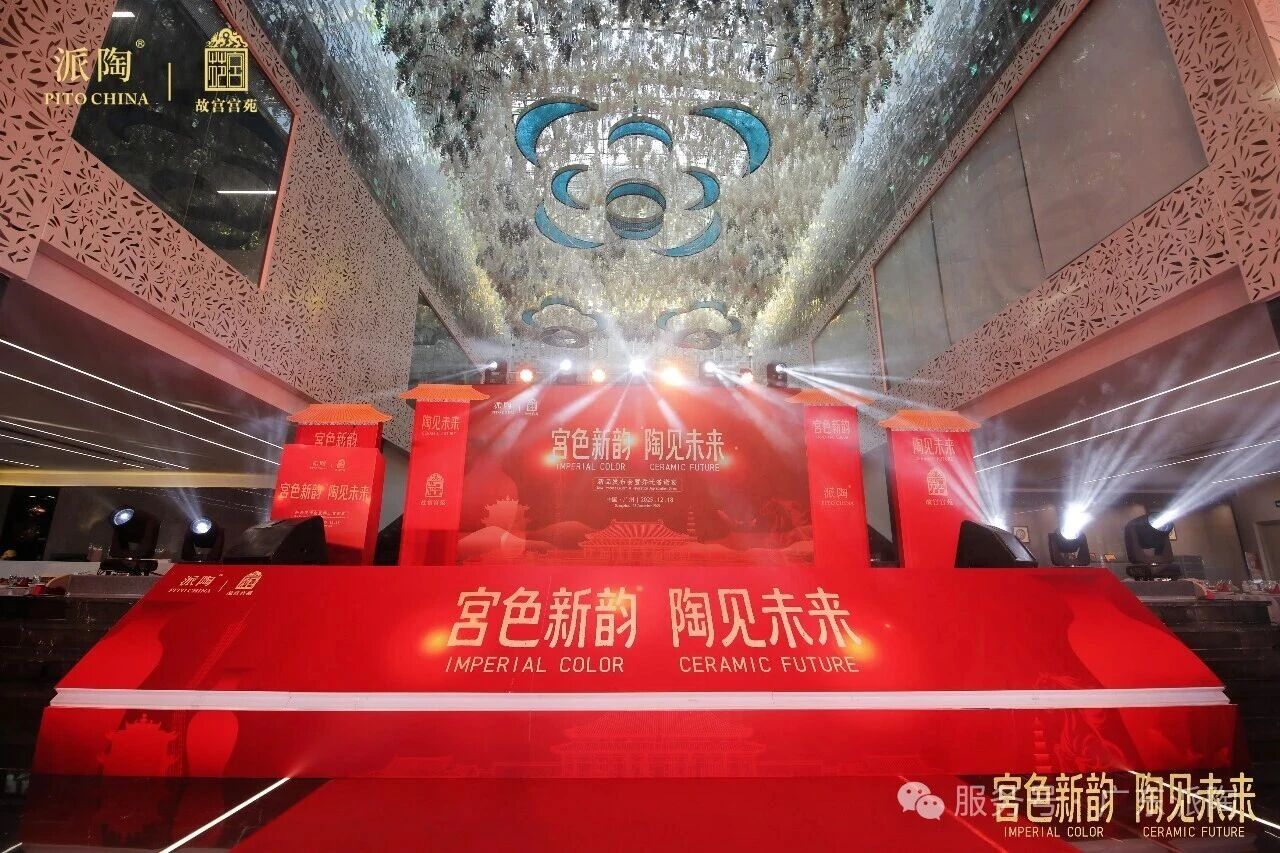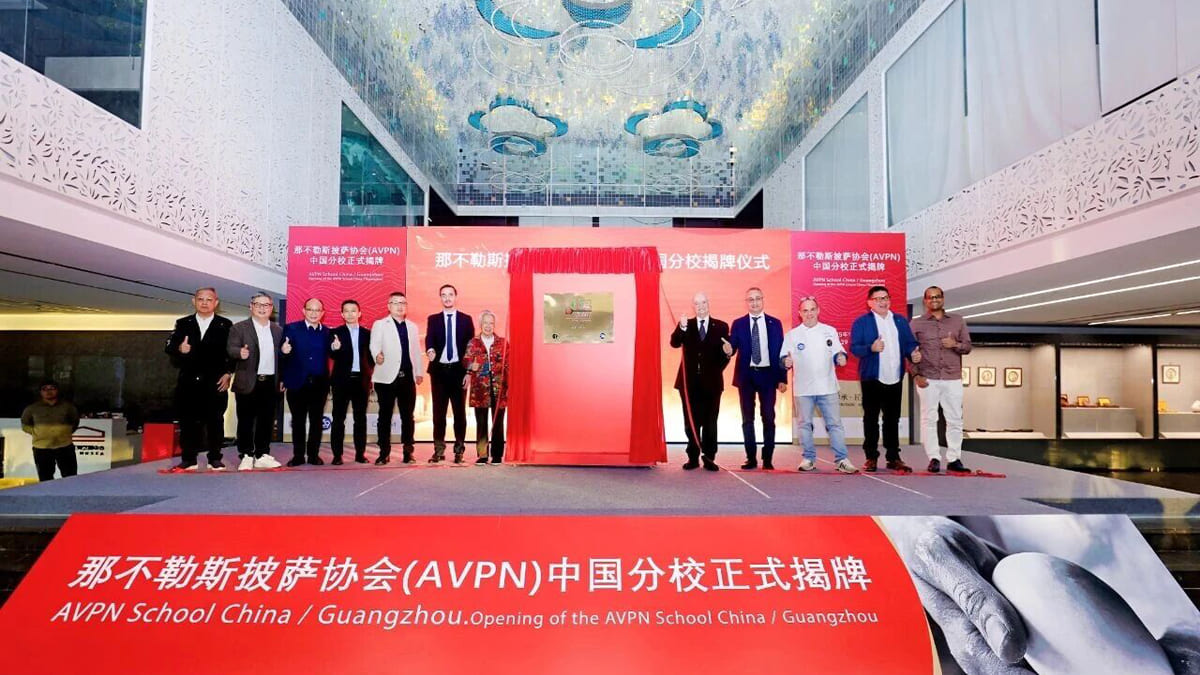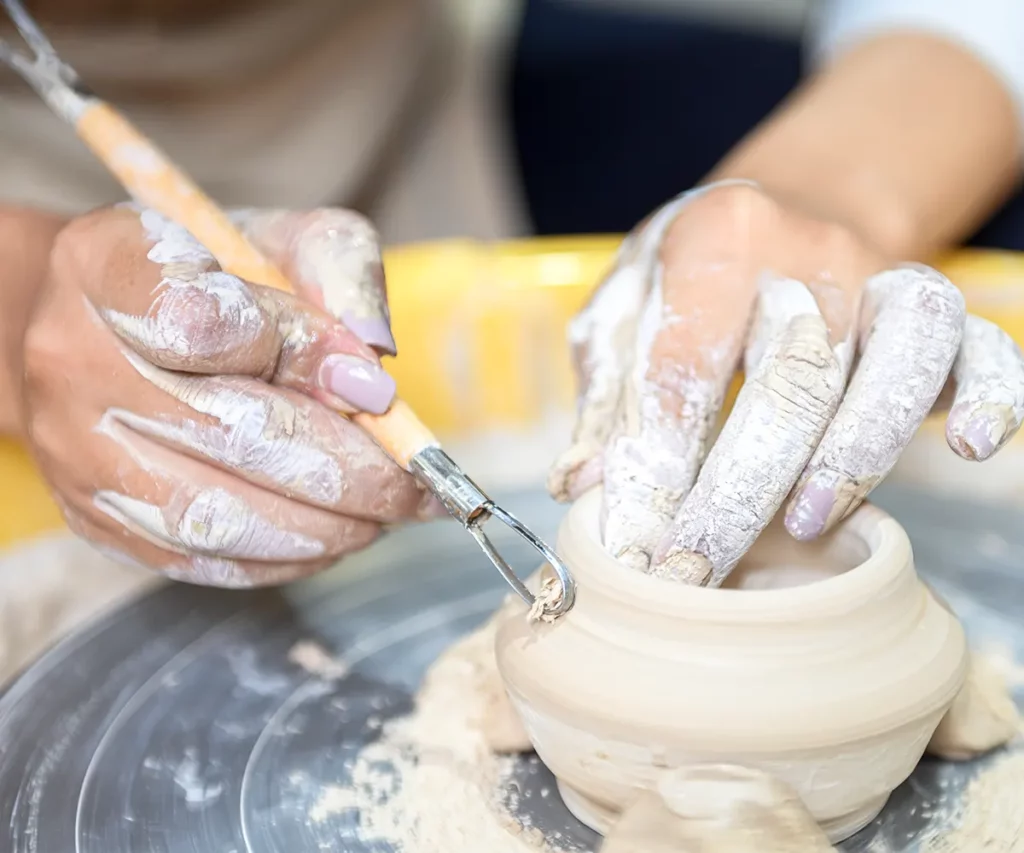
Porzellanteller sind ein wesentlicher Bestandteil unseres täglichen Lebens, schmücken unsere Tische mit Eleganz und Schönheit. Die aufwendige Handwerkskunst und die Liebe zum Detail, die bei der Herstellung dieser Teller zum Einsatz kommen, sind wirklich beeindruckend. In diesem Artikel, Wir werden uns den faszinierenden Prozess der Herstellung von Porzellantellern genauer ansehen, Von der Entstehungsgeschichte bis zum Endbrand und der Qualitätskontrolle.
Geschichte der Chinateller
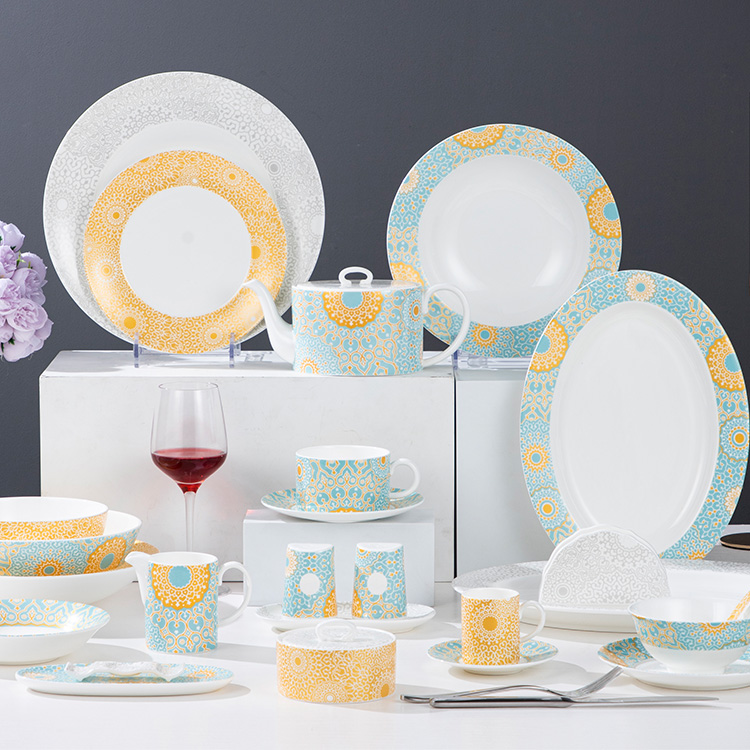
Porzellanteller haben eine reiche und geschichtsträchtige Geschichte, die mehrere Jahrhunderte zurückreicht. Die Ursprünge von Porzellantellern lassen sich bis ins alte China zurückverfolgen, wo sie ursprünglich für den kaiserlichen Hof geschaffen wurden. Diese Teller wurden wegen ihres filigranen Designs und ihrer exquisiten Handwerkskunst hoch geschätzt.
Chinateller Im 16. Jahrhundert erlangte es in westlichen Kulturen erstmals Popularität, als sich Handelswege zwischen China und Europa öffneten. Die Teller wurden schnell zum Symbol für Reichtum und Luxus, schmücken die Tische des Adels und der gesellschaftlichen Elite.
Woraus bestehen Porzellanteller??

Bei der Herstellung von Porzellantellern werden verschiedene Materialien verwendet, um die perfekte Mischung aus Festigkeit zu schaffen, Transluzenz, und Schönheit. Die Hauptbestandteile von Porzellantellern sind Ton und Kaolin, ein feiner weißer Ton das für seine Reinheit und seinen geringen Eisengehalt bekannt ist. Diese Materialien werden sorgfältig ausgewählt, um die Platten zu gewährleisten’ Haltbarkeit und Ästhetik.
Neben Ton und Kaolin, Im Produktionsprozess werden andere Materialien verwendet, wie zum Beispiel Feldspat, Quarz, und Knochenasche. Feldspat trägt dazu bei, die Schmelztemperatur des Tons zu senken, während Quarz der Platte Festigkeit verleiht. Knochenasche, aus Tierknochen gewonnen, wird verwendet, um den Weißgrad und die Transluzenz der Platten zu verbessern.
Schritt #1: Ernte und Vorbereitung des Tons
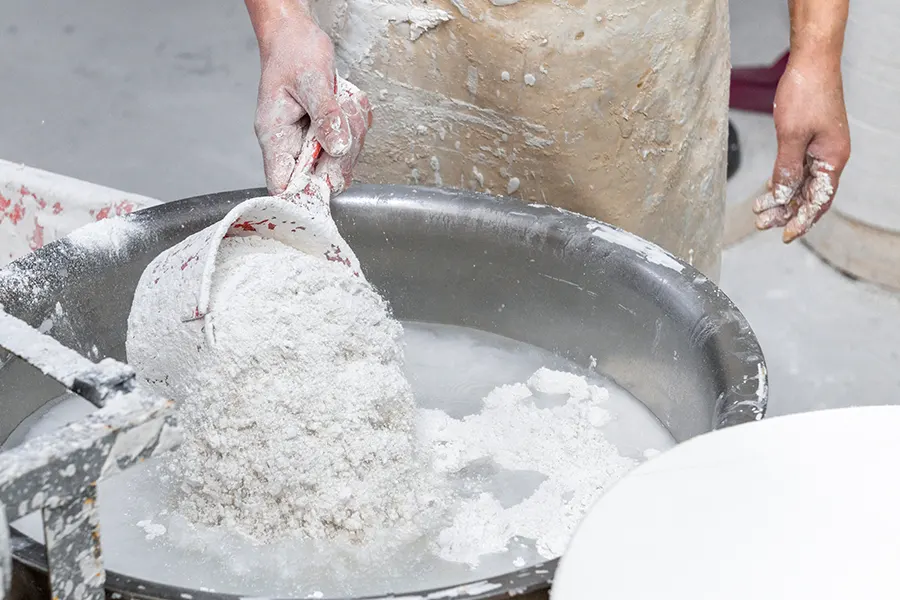
Der Prozess der Herstellung von Porzellantellern beginnt mit der Gewinnung von Ton aus spezialisierten Minen. Der Ton wird sorgfältig gewonnen, um seine Reinheit und Qualität sicherzustellen. Sobald der Ton geerntet ist, Es wird einer Reihe von Vorbereitungsmethoden unterzogen, um Verunreinigungen zu entfernen und seine Verarbeitbarkeit zu verbessern.
Zu diesen Zubereitungsmethoden gehört das Waschen, Schleifen, und Sieben des Tons, um ein feines Pulver zu erzeugen. Dieses Pulver wird dann mit Wasser vermischt, um eine Tonaufschlämmung zu bilden, die im Plattenproduktionsprozess verwendet werden.
Schritt #2: Formen des Plattenkörpers
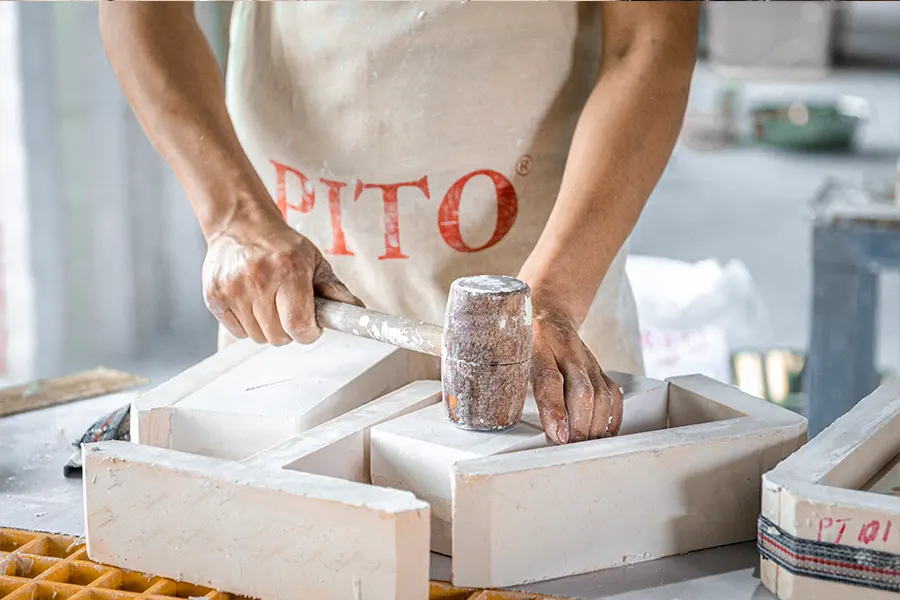
Sobald die Tonaufschlämmung vorbereitet ist, Es ist Zeit, den Plattenkörper zu formen. Für diesen Prozess kommen verschiedene Methoden zum Einsatz, einschließlich Schlickerguss, Jiggering, und drückend.
- In Schlickerguss, Der Tonbrei wird in Gipsformen gegossen, die den Wasseranteil aufnehmen, eine Lehmschicht zurücklassen. Anschließend wird diese Tonschicht vorsichtig aus der Form genommen und in die gewünschte Plattenform geformt.
- Jiggering Dabei kommt eine rotierende Form zum Einsatz, die den Plattenkörper beim Drehen formt. Diese Methode ermöglicht eine präzisere Formgebung und eine gleichmäßige Dicke der gesamten Platte.
- Drücken, andererseits, Dabei wird der Tonschlamm zwischen zwei Formen gepresst, um die Plattenform zu erzeugen. Diese Methode wird häufig für größere Platten oder Platten mit komplizierten Designs verwendet.
Schritt #3: Den Teller formen und gestalten
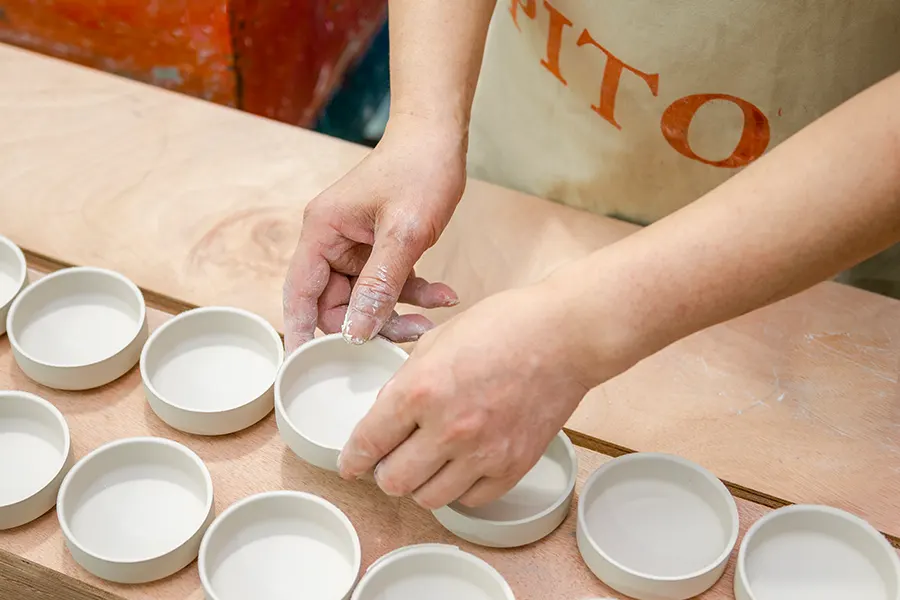
Nachdem der Plattenkörper geformt wurde, Es ist Zeit, es zu seinem endgültigen Design zu formen. Für diesen Prozess kommen verschiedene Techniken zum Einsatz, wie zum Beispiel Trimmen, drehen, und Prägung.
- Trimmen Dabei wird überschüssiger Ton von den Plattenrändern entfernt und ein glatter und gleichmäßiger Rand geschaffen.
- Drehen bezieht sich auf den Prozess der Formung des Fußrings, was der Platte Stabilität verleiht.
- Prägung ist eine dekorative Technik, bei der erhabene Muster oder Muster auf der Telleroberfläche erzeugt werden.
In Bezug auf Plattendesigns und -muster, Es gibt eine große Auswahl an Optionen. Von traditionellen Blumenmotiven bis hin zu modernen abstrakten Designs, Porzellanteller bieten endlose Möglichkeiten für kreativen Ausdruck.
Schritt #4: Trocknen der Platte

Nach dem Gestaltungs- und Gestaltungsprozess, Die Platten müssen einem sorgfältigen Trocknungsprozess unterzogen werden. Eine kontrollierte Trocknung ist entscheidend, um ein Verziehen oder Reißen der Platten zu verhindern.
Die Platten werden in einen sorgfältig kontrollierten Trockenraum mit kontrollierter Luftfeuchtigkeit und Temperatur gestellt. Dieser langsame und allmähliche Trocknungsprozess ermöglicht eine gleichmäßige Trocknung des Tons, sorgt dafür, dass die Platten ihre Form und Stabilität behalten.
Schritt #5: Biskuitfeuer
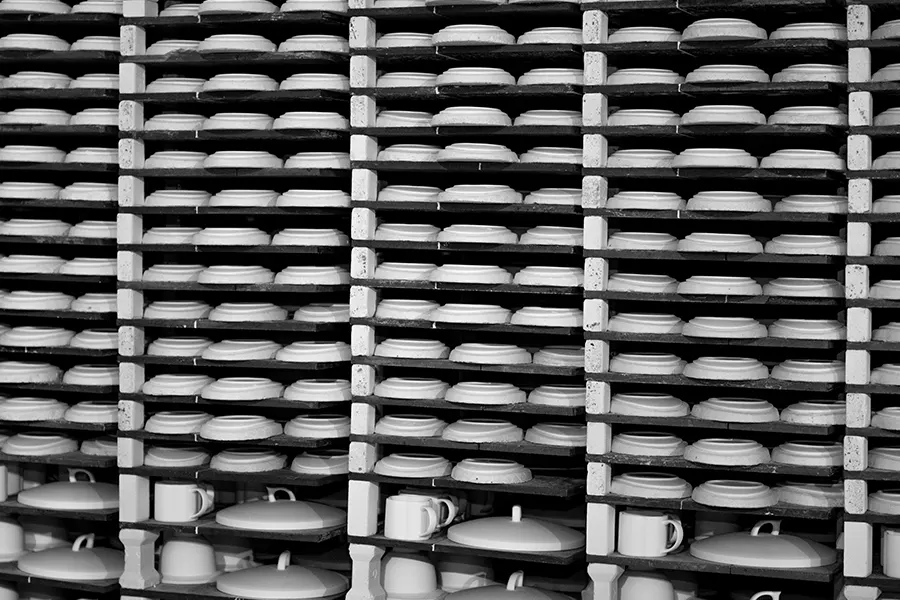
Sobald die Platten getrocknet sind, Sie sind bereit für den ersten Brand, bekannt als Biskuitbrand. Beim Biskuitbrand werden die Platten auf eine hohe Temperatur erhitzt, typischerweise um 1832°F (1000°C), für eine bestimmte Dauer, meist mehrere Stunden.
Dieser Brennvorgang dient dazu, die Platten zu härten und für den Glasurvorgang vorzubereiten. Die hohe Temperatur trägt auch dazu bei, eventuelle Restfeuchtigkeit im Ton zu entfernen, um sicherzustellen, dass die Platten robust und langlebig sind.
Schritt #6: Glasieren der Platte
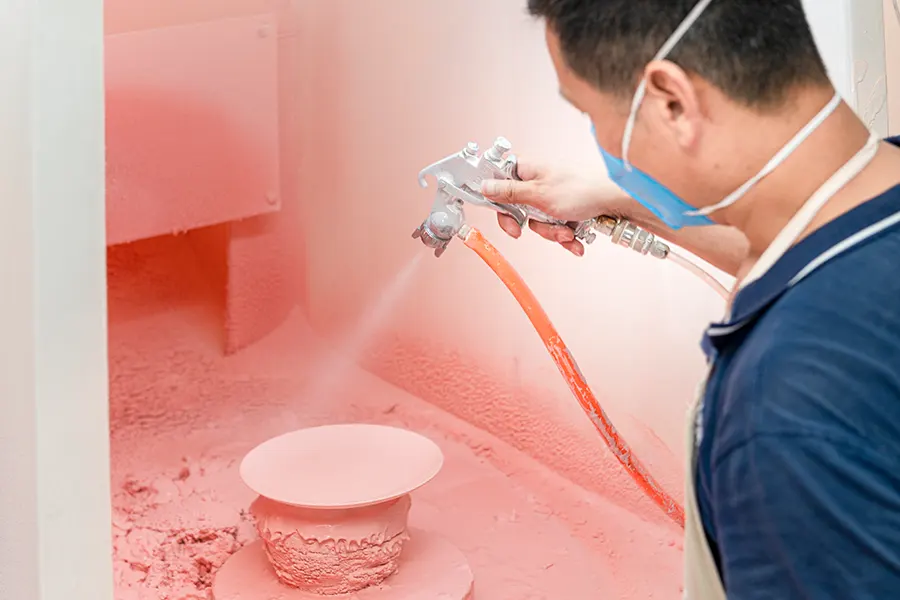
Nach dem Biskuitbrand, Die Teller sind bereit zum Glasieren. Die Glasur verleiht den Tellern ein schönes Finish und wertet ihre Optik auf. Es gibt verschiedene Arten von Glasuren für Porzellanteller, einschließlich transparenter Glasuren, farbige Glasuren, und strukturierte Glasuren.
Bei der Glasur wird die Glasur mit verschiedenen Methoden, beispielsweise durch Sprühen, auf die Platten aufgetragen, eintauchen, oder bürsten. Anschließend werden die Platten ein zweites Mal bei niedrigerer Temperatur gebrannt, Lassen Sie die Glasur schmelzen und mit dem Tonkörper verschmelzen.
Schritt #7: Porzellanteller dekorieren
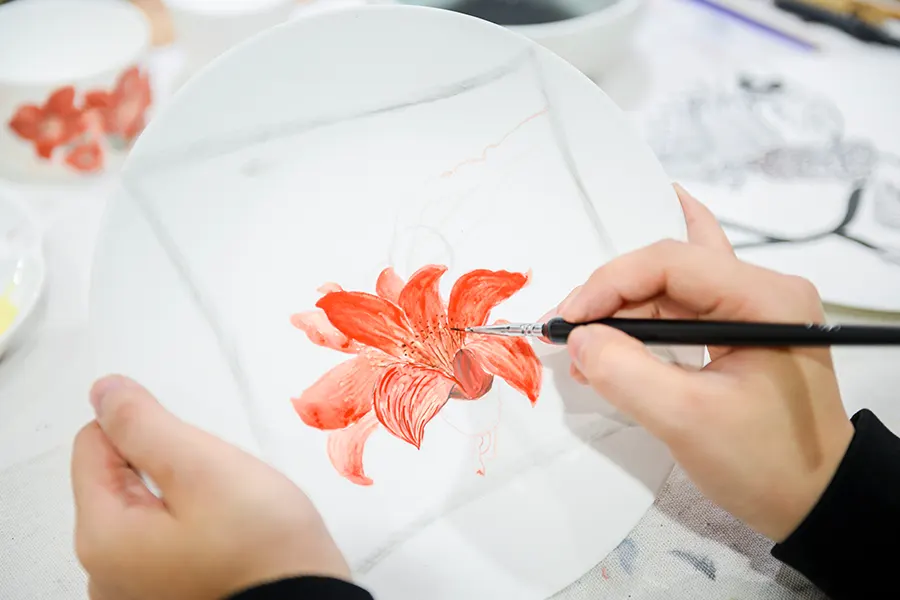
Sobald die Teller glasiert sind, Sie sind bereit für den Dekorationsprozess. Porzellanteller können mit verschiedenen Techniken dekoriert werden, beide traditionell und modern.
- Traditionell Zu den dekorativen Methoden gehört die Handbemalung, Unterglasur-Transferdruck, und Handgravur. Diese Techniken erfordern großes Geschick und Präzision, da es sich um komplizierte Designs und Muster handelt.
- Modern Zu den dekorativen Methoden gehört der Siebdruck, Aufkleberanwendung, und Digitaldruck. Diese Methoden ermöglichen komplexere Designs und die Reproduktion feiner Details.
Schritt #8: Brennen der Platten
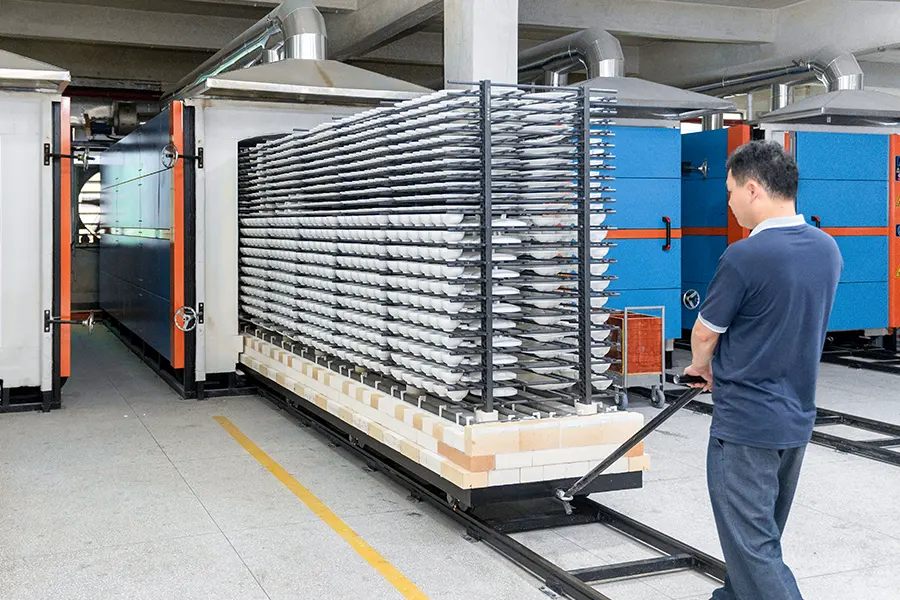
Nach dem dekorativen Prozess, Die Platten werden abschließend bei hoher Temperatur gebrannt, typischerweise um 2372°F (1300°C). Durch diesen Brand wird sichergestellt, dass das Dekor dauerhaft mit der Glasur und dem Tonkörper verschmilzt, Schaffung eines haltbaren und langanhaltenden Finishs.
Das Hochtemperaturbrennen trägt außerdem dazu bei, die Farben hervorzuheben und die komplizierten Details der Dekoration hervorzuheben. Beim abschließenden Brennen kommt die wahre Schönheit der Porzellanteller zum Vorschein.
Schritt #9: Inspektion und Qualitätskontrolle
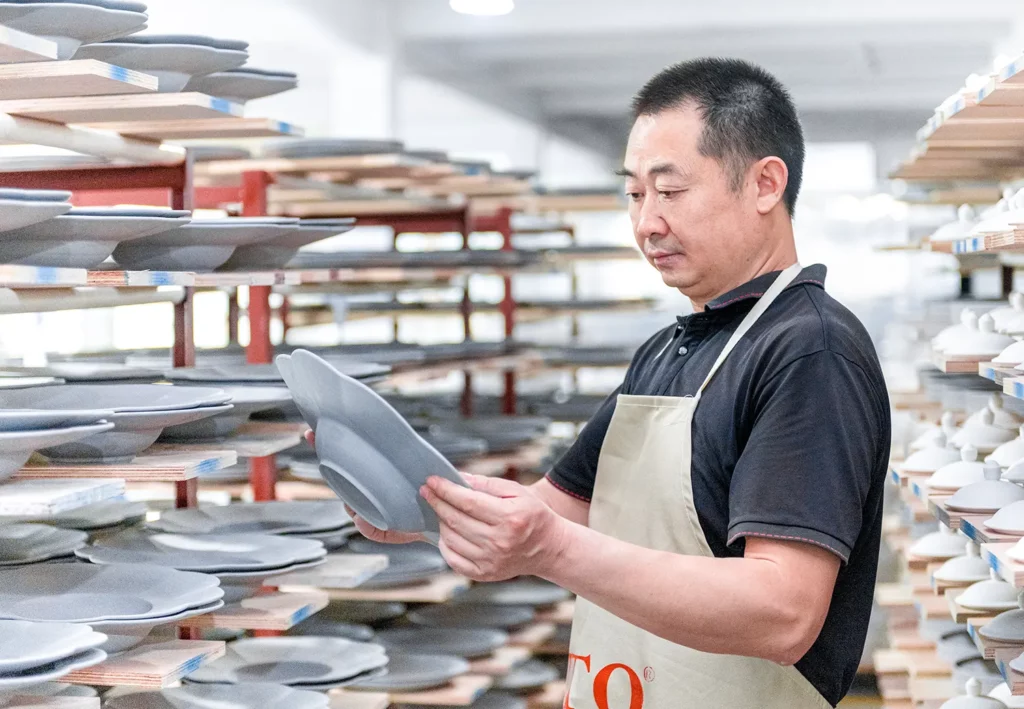
Bei der Herstellung von Porzellantellern ist die Qualitätskontrolle von größter Bedeutung. Jeder Teller durchläuft einen strengen Prüfprozess, um sicherzustellen, dass er den höchsten Standards an Handwerkskunst und Qualität entspricht.
Prüfer untersuchen jede Platte sorgfältig auf etwaige Mängel oder Unvollkommenheiten, wie zum Beispiel Risse, ungleichmäßige Glasur, oder Unstimmigkeiten in der Farbe. Alle Platten, die die festgelegten Kriterien nicht erfüllen, werden entsorgt oder zur weiteren Anpassung zurückgeschickt.
Schritt #10: Verpackung und Versand
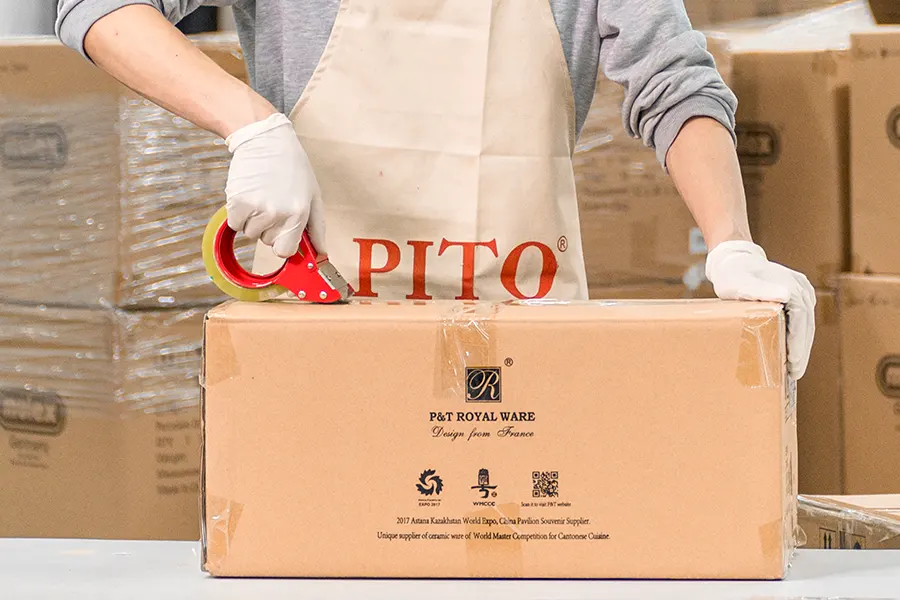
Sobald die Platten die Prüfung bestanden haben, Sie sind bereit zum Verpacken und Versenden. Beim Verpackungsprozess wird jeder Teller sorgfältig in Schutzmaterialien eingewickelt, wie Luftpolsterfolie oder Schaumstoff, um Bruch während des Transports zu verhindern.
Porzellanteller werden oft in stabilen Kartons oder Holzkisten verpackt, um zusätzlichen Schutz zu bieten. Bei der Kennzeichnung der Pakete und der sorgfältigen Behandlung während des gesamten Versandprozesses wird besondere Sorgfalt darauf verwendet.
Wartung und Pflege von Porzellantellern
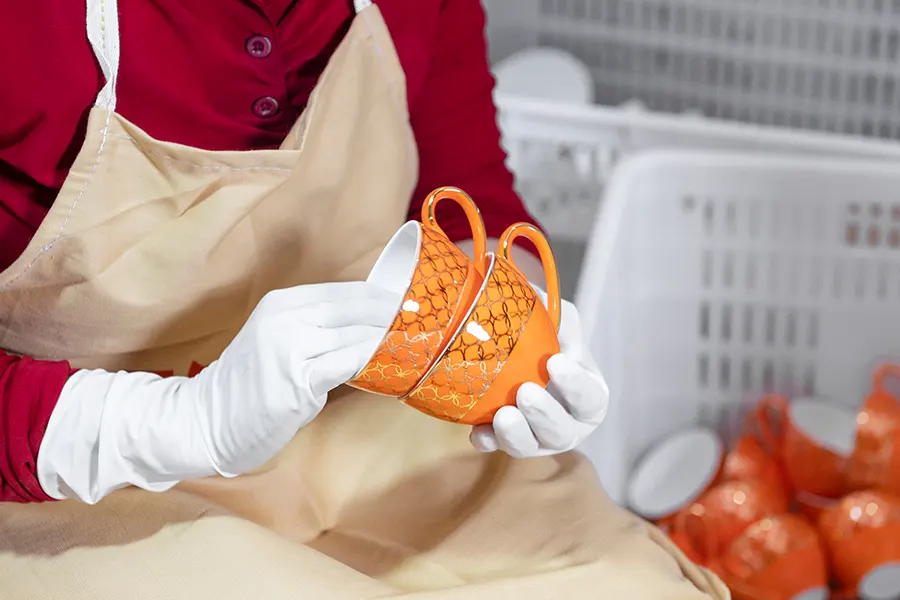
Um die Langlebigkeit von Porzellantellern zu gewährleisten, Die richtige Wartung und Pflege ist unerlässlich. Hier finden Sie einige Tipps und Richtlinien zur Pflege Ihrer Porzellanteller:
- Setzen Sie Porzellanteller keinen extremen Temperaturschwankungen aus, da dies dazu führen kann, dass sie reißen oder zerbrechen.
- Waschen Sie Porzellanteller von Hand mit warmem Wasser und mildem Spülmittel, mit einem weichen Schwamm oder Tuch. Vermeiden Sie scharfe Scheuermittel oder Scheuerbürsten.
- Trocknen Sie Porzellanteller sofort nach dem Waschen, um Wasserflecken oder Flecken zu vermeiden.
- Lagern Sie Porzellanteller in einer trockenen und staubfreien Umgebung, Am besten in einer Vitrine oder einem Porzellanschrank. Verwenden Sie Schutzpolster oder Filzeinlagen, um Kratzer zu vermeiden.
- Vermeiden Sie es, Porzellanteller direkt übereinander zu stapeln, da dies zu Absplitterungen oder Kratzern führen kann. Verwenden Sie für zusätzlichen Schutz Tellertrenner oder weiche Stoffservietten zwischen den Tellern.
Abschluss
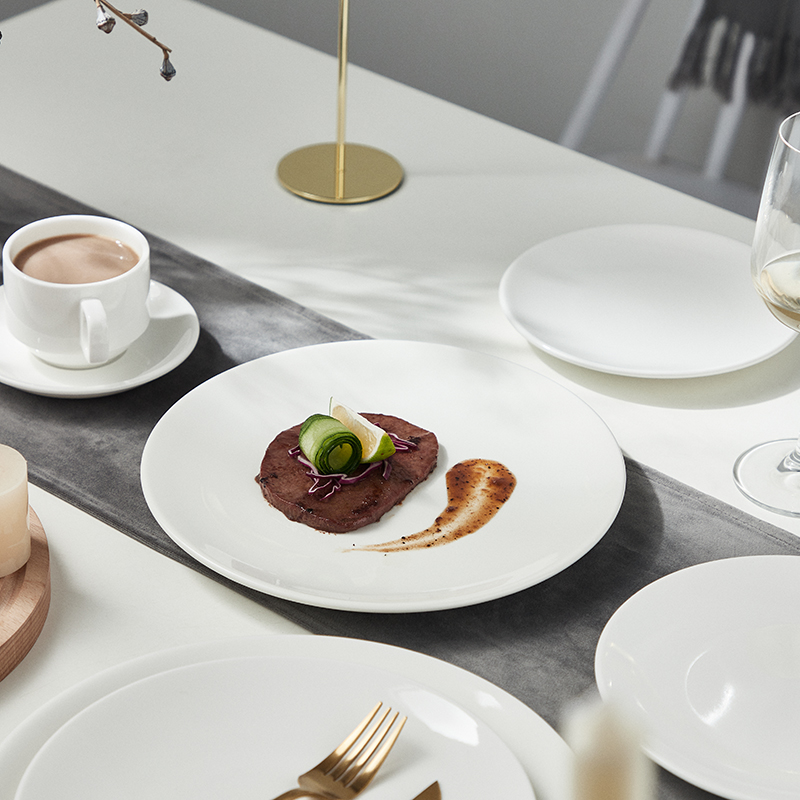
Die Herstellung von Porzellantellern ist eine bemerkenswerte Mischung aus Kunstfertigkeit und Handwerkskunst. Von der sorgfältigen Auswahl der Materialien bis hin zum aufwendigen Form- und Designprozess, Jeder Schritt bei der Herstellung dieser Teller erfordert Geschick und Geduld. Das Ergebnis ist ein Meisterwerk an Eleganz und Schönheit, das unsere Tische schmückt und unseren kulinarischen Erlebnissen einen Hauch von Raffinesse verleiht. Also, Wenn Sie das nächste Mal auf feinem Porzellan speisen, Nehmen Sie sich einen Moment Zeit, um die Kunstfertigkeit und Hingabe zu würdigen, die in die Herstellung eines so bemerkenswerten Geschirrstücks geflossen ist.
Häufig gestellte Fragen
1. Woraus bestehen Porzellanteller??
Porzellanteller werden hauptsächlich aus Ton und Kaolin hergestellt, mit Zusatzstoffen wie Feldspat, Quarz, und Knochenasche, um ihre Festigkeit und Lichtdurchlässigkeit zu erhöhen.
2. Was ist das Besondere an Porzellantellern?
Porzellanteller sind für ihre Eleganz bekannt, Haltbarkeit, und komplizierte Designs. Die sorgfältige Handwerkskunst und die Liebe zum Detail, die in ihre Produktion fließen, unterscheiden sie von anderen Tellerarten.
3. Sind Porzellanteller mikrowellengeeignet??
Die meisten Porzellanteller sind mikrowellengeeignet, Es ist immer wichtig, das zu überprüfen Hersteller von KeramikgeschirrRichtlinien. Einige empfindliche oder handbemalte Porzellanteller sind möglicherweise nicht für die Mikrowelle geeignet.
4. Darf Porzellangeschirr in die Spülmaschine??
Ja, Porzellangeschirr kann grundsätzlich in die Spülmaschine gegeben werden. Jedoch, Es ist wichtig, die Richtlinien des Herstellers oder die spezifischen Pflegehinweise für Ihr Porzellangeschirr zu prüfen, um sicherzustellen, dass es spülmaschinenfest ist. Einige empfindliche oder handbemalte Porzellangeschirre müssen möglicherweise von Hand gespült werden, um ihr Aussehen und ihre Langlebigkeit zu bewahren.
